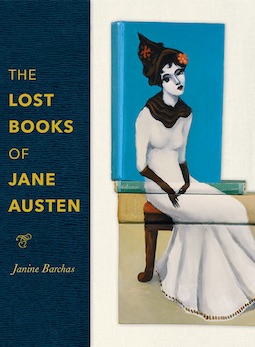By Louis J. Kern
“For readers today,” Helena Kelly wrote, “opening one of Jane’s novels, there’s an enormous amount standing between them and the text. There’s the passage of two hundred years, for a start, and there’s everything else—biographies and biopics . . . the adaptations and sequels, rewritings and reimaginings” (Jane Austen: The Secret Radical, 2017). Burchas seeks to illuminate one of the key questions of Austen scholarship: how did she go from marginality to become the “divine Jane,” the “most popular author since Shakespeare?” Her lavishly illustrated volume situates the roots of Austen’s literary ascent in expanded literacy (the Universal Education Act, UK, 1870 and compulsory education, U.S.), publication of cheap, ephemeral paperback copies of her work, and technological advances in print technology. Reception of Austen’s work and her rising reputation occurred not in high literary circles but via a greatly expanded audience grounded in shoddy reprintings that were sold in railway stations, offered as commercial giveaways, presented as prizes in clubs and Sunday schools, and consciously marketed to the working class.
Contra its title, this is not a volume about lesser-known, unpublished, or fragmentary manuscripts; nor does it consider juvenilia like Love and Friendship (1791) unfinished works like Sanditon (1817, currently on BBC TV), or posthumous works like Lady Susan (1871) and The Watsons (1871). Its focus is on cheap, throwaway publications that are largely absent from the most complete catalogs of Austen’s works. This is not a book for the general reader. While a diligent reading will yield interesting insights into the history of printing and publication and the reception of Austen’s oeuvre, it appeals most strongly to bibliophiles, archivists, bibliographers, serious collectors, and the most hardcore Janeites. It provides essential additions to the Austen bibliography, extending the most comprehensive survey—David Gilson’s A Bibliography of Jane Austen (1982,1997).
Barchas offers a corrective to the conventional assumption that Austen produced exclusively domestic romances, whose audience was overwhelmingly female. Cheap editions were read by coal miners and in the trenches during WWI. Like Dickens, her works were serialized, and in schmaltzy editions produced by John Thomas Dicks in the 1880s, sensationalized to rival Penny Dreadfuls. The “yellowback” editions of the 1850s sported lurid covers that anticipated the Dime Novels. They were used as giveaways à la Gideons in the Hotel Taft and as premiums for Lever soap in the UK. Religious tract societies awarded copies as prizes and the temperance movement in Britain—the Pleasant Sunday Afternoon Society—presented promotional copies. More appositely, British suffragettes developed a proto-feminist reading of Austin.
Austen’s works pioneered the paperback revolution, piggybacking on the critical transition from hand-set type to stereotyping, allowing multiple reuse of a single impression, and, larger runs at greatly reduced cost. Barchas convincingly demonstrates that production of these cheaper editions vastly enhanced distribution, made Austen a household name, enhanced her literary fame, and insured her transition to the literary canon.
Although associated with children’s books in the 1890s, and widely distributed by Paperback Books to troops in WWII, the 1950s retrenchment to domesticity issued in their primary association with women. Currently, Janeites (fans) seem to be largely female and gay males. (Cf. Deidre Lynch, ed. Janeites: Austen’s Disciples and Devotees, 2000). Her popularity predictably led to parodic refractions—Pride and Prejudice and Zombies (2016), three Hallmark Christmas movies (2018-19), and Kate Coombs’ Good Night Mr. Darcy (2014).
Barchas provides the deep historical substratum that underlies her enduring popularity and marketability, a context that perchance will promote her goal of spurring private collectors and archivists to cooperatively gather these ephemeral materials into a single central location made available to students and scholars.
Louis J. Kern (ΦBK, Clark University) is professor emeritus of history at Hofstra University. Hofstra University is home to the Omega of New York chapter of Phi Beta Kappa.




